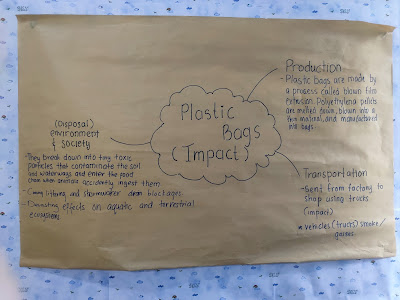Based on curriculum specifications - Core value: Responsibility (Global Sustainability)
Objectives:
1) Students will be able to categorize environmentally friendly and non-environmentally products.
2) Students will be able to evaluate the impact of their consumption choices on transportation, production, and the environment, society, and their own well-being.
3) Students will be able to identify products that align with their values and boycott products that go against their beliefs.
Materials: Whiteboard and markers, video, computer, big paper
Procedure:
Show video
Warm-up (10 mins):
1. Ask students what is the item shown on the video and what are the environmental impacts as a result of the product?
2. Ask students to brainstorm the different types of products they consume on a daily basis. Write these on the whiteboard. Then ask students to categorize these products as either environmentally friendly or not.
Evaluation of consumption choices (20 mins):
1. Teacher divides students into groups of 4-5.
2. Provide big white paper to the students.
3. Ask students to choose one product they consume regularly and research the impact of its production, transportation, and disposal on the environment and society. Once they have completed their research, ask them to fill out the big white paper, evaluating the impact of their consumption choice on the environment, society, and their own well-being.
4. Every group pastes their work (the big paper) around the classroom.
Evidence from my class:
5. Instruct the students to do a gallery walk and have individual students think about which product they would like to boycott due to its impact on the environment, society, and well-being. Every group will stay at one spot for one minute and then they rotate.
Speaking activity :
Students explain the reason they want to boycott the item and explain the manner in which they do this.
Conclusion (10 mins): Summarize the key points of the lesson and ask students to reflect on their own consumption habits. Encourage them to consider how they can make more mindful and politically informed choices in their future consumption habits.
Reflection: Being critical of our product consumption requires thinking about factors that are not immediate and indirect but can have an impact on the environment nonetheless. For these groups of students, aid them to see the hidden factors that can have an environmental impact due to our consumption of certain products such as transportation.









Comments
Post a Comment